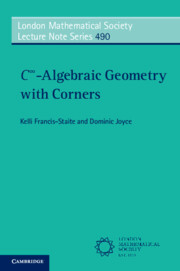Book contents
- Frontmatter
- Contents
- 1 Introduction
- 2 Background on C∞–schemes
- 3 Background on manifolds with (g–)corners
- 4 (Pre) C∞–rings with corners
- 5 C∞–schemes with corners
- 6 Boundaries, corners, and the corner functor
- 7 Modules, and sheaves of modules
- 8 Further generalizations and applications
- References
- Glossary of Notation
- Index
5 - C∞–schemes with corners
Published online by Cambridge University Press: 05 January 2024
- Frontmatter
- Contents
- 1 Introduction
- 2 Background on C∞–schemes
- 3 Background on manifolds with (g–)corners
- 4 (Pre) C∞–rings with corners
- 5 C∞–schemes with corners
- 6 Boundaries, corners, and the corner functor
- 7 Modules, and sheaves of modules
- 8 Further generalizations and applications
- References
- Glossary of Notation
- Index
Summary
We study new categories of ’ $C^\infty$-schemes with corners’, following the definition of schemes in Algebraic Geometry. A ‘(local) $C^\infty$-ringed space with corners’ is a topological space with a sheaf of $C^\infty$-rings with corners. We define a spectrum functor from $C^\infty$-rings with corners to local $C^\infty$-ringed spaces with corners, adjoint to the global sections functor. Then a $C^\infty$-scheme with corners is a local $C^\infty$-ringed space with corners which is locally isomorphic to the spectrum of a $C^\infty$-ring with corners.
Manifolds with (g-)corners embed into $C^\infty$-schemes with corners as full subcategories. Thus, $C^\infty$-schemes with corners are a vast generalization of manifolds with corners and manifolds with g-corners.
In ordinary Algebraic Geometry, the spectrum functor is full and faithful, but for $C^\infty$-rings with corners neither holds. ‘Semi-complete’ $C^\infty$-rings with corners are a special class on which the spectrum functor is faithful and surjective, but not full.
We study special classes of $C^\infty$-schemes with corners, and existence of fibre products of $C^\infty$-schemes with corners.
Information
- Type
- Chapter
- Information
- C∞-Algebraic Geometry with Corners , pp. 107 - 136Publisher: Cambridge University PressPrint publication year: 2024
